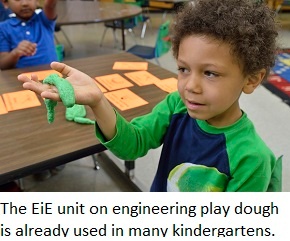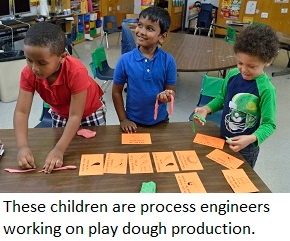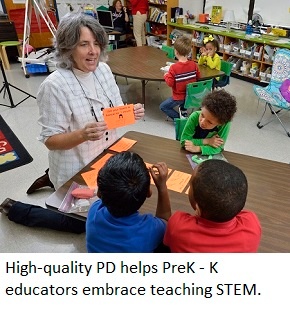 In his 2013 State of the Union address, President Obama charged Congress with making high-quality pre-school available for every child in the country. High-quality preschools have well-trained teachers, small class sizes, and a rigorous curriculum . . . and with regard to curriculum, the National Science Teachers Association strongly advocates for preschool instruction in science and engineering.
In his 2013 State of the Union address, President Obama charged Congress with making high-quality pre-school available for every child in the country. High-quality preschools have well-trained teachers, small class sizes, and a rigorous curriculum . . . and with regard to curriculum, the National Science Teachers Association strongly advocates for preschool instruction in science and engineering.
That raises a challenge: engineering curricula designed for very young children are so rare as to be almost non-existent. With this need in mind, the EiE project starts work this fall on a new engineering curriculum for ages 3 to 5.
Research Based and Teacher Tested
“Like all our curricula, our PreK-K curriculum will be research-based and developed in close consultation with the educators who are on the front lines, in preschool and kindergarten classrooms,” says EiE director Christine Cunningham. “One reason for the success of our flagship elementary curriculum is our iterative approach to design; we got methodical feedback from classroom teachers who are most familiar with the challenges, constraints, and opportunities in a typical classroom.”
 Our development process will also be informed by insights from some of the top minds in early childhood education. For the past year, Cunningham has been a member of the Early Childhood STEM Working Group, a joint initiative of the University of Chicago’s Center for Elementary Math and Science Education and the Early Math Collaborative at the Erikson Institute.
Our development process will also be informed by insights from some of the top minds in early childhood education. For the past year, Cunningham has been a member of the Early Childhood STEM Working Group, a joint initiative of the University of Chicago’s Center for Elementary Math and Science Education and the Early Math Collaborative at the Erikson Institute.
The group aims to identify both the classroom practices that are most effective in supporting early STEM learning AND the key research needs in the field. There's already plenty of evidence that early learning programs can help level the playing field for children from lower income families: enhancing vocabulary, promoting social and emotional development, and generally helping kids be ready for school.
STEM for Schools with Limited Budgets
One key part of our plan for a new PreK – K curriculum is that it will be available for free, online, following the model established with our afterschool curricula, Engineering Adventures (for grades 3–6) and Engineering Everywhere (for grades 6–8) (Pre-printed educator guides will also be available through the EiE Store.)
“We know many early childhood programs face budgetary constraints,” Cunningham says. “We’re committed to reinvesting resources to offer the widest support possible for engineering education.” Also in line with our afterschool model, a free downloadable professional development guide is in the works.
Support for Educators New to STEM
“Kids in PreK-K classrooms are already designing with a purpose: building block structures to house an imaginary zoo, or running a lemonade factory at the water table,” says Jeff Winokur, an early childhood and elementary science educator at Wheelock College. “The challenge is, teachers may not think of these activities as engineering. Or they may not know the pedagogical strategies to support this kind of learning—for example, reacting with, “Wow, how did you get the lemonade to go into the jar?” instead of just “Lemonade, how tasty!”
 “The EiE initiative has great potential to address this need for teacher support,” Winokur says, “and also to help educators see, they don’t have to buy a lot of new stuff to do engineering.”
“The EiE initiative has great potential to address this need for teacher support,” Winokur says, “and also to help educators see, they don’t have to buy a lot of new stuff to do engineering.”
The three-year, $500K initiative will be funded by sustainable reinvestment from the EiE project. We expect to recruit preschools and kindergartens for pilot tests of the new units; if you’re interested, sign up for our newsletter to receive pilot-test notices. We hope to release the first new preschool unit in 2017.
Engineering is Elementary is a project of the National Center for Technological Literacy® at the Museum of Science, Boston.








